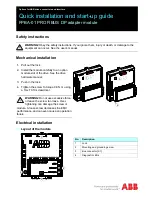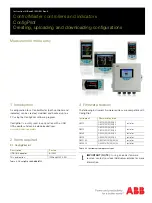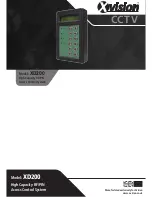
VOLTAGE ADJUST
The screwdriver adjustable potentiometer adjusts the generator
output voltage. Adjustment clockwise increases the generator
output voltage.
When using a remote voltage adjust rheostat, remove the jumper
wire across terminals 6 and 7 and install a 2000 ohm 1/2 watt
(minimum) rheostat. (See Figure 2). This will give ±10% voltage
variation from the nominal. (For ±5% voltage variation use a 1000
ohm 1/2 watt rheostat).
STABILITY ADJUST
System stability is the ability of the generator to respond to load
transients. Decreasing the stability makes the generator less slug-
gish and faster to respond to load transients. If the stability of the
regulator is decreased too much, the generator will tend to hunt
under steady state conditions.
The screwdriver adjustable potentiometer adjusts the system
stability. Adjustment clockwise increases the stability. In-
creasing the stability increases the response time of the generator.
Conversely, decreasing the stability decreases the response time
of the generator.
Stability Selection (On applicable regualtor models)
When excitation under voltage, it can result in insufficient adjust-
ment range for stability adjustment and when excitation over
voltage, the response from the AVR becomes sluggish. The AVR
is equipped with 2 bridging wires J1 and J2 to help improve this
problem. See Figure 2.
• If the unloaded excitation voltage is less than 7 VDC, please cut
open the J2 red bridging wires.
• If the unloaded excitation voltage is greater than 25 VDC,
please cut open the J1 white bridging wires.
V/HZ ROLL-OFF FREQUENCY SELECTION
The roll-off point is the frequency where the generator voltage
starts to decrease. This reduces the Kilowatt load to the engine,
which allows the engine to recover in speed under any load tran-
sient condition.
Use jumper to select 50 Hz or 60 Hz. The screwdriver adjustable
potentiometer sets the roll-off frequency from 54-61 Hz in the 60
Hz setting or from 45-51 Hz in the 50 Hz setting.
The SE350E has the roll-off point preset to 58 Hz in the 60 Hz
mode and 48 Hz in the 50 Hz mode. To change the roll-off point,
adjust engine speed to the desired rated speed. (50 or 60 Hz).
Set the voltage to the desired setting at rated speed. Adjust en-
gine speed to the desired roll-off point. Turn the potentiometer
clockwise until the voltage starts to drop off. Then adjust the po-
tentiometer counter-clockwise until the voltage returns to rated.
Re-adjust engine speed to rated speed.
START-UP PROCEDURE
PRELIMINARY SET-UP
Ensure the voltage regulator is correctly connected to the
generator. Refer to the specific connection diagram supplied
with the generator.
Set the regulator voltage adjust to full counter-clockwise
(minimum voltage level).
Set the remote voltage adjust (if used) to the center position.
Set the stability control full clockwise (maximum stability
level).
Connect the positive lead of a 100V D.C. voltmeter to F1 and
the negative lead of the voltmeter to F2 or use an appropri-
ate AC voltmeter on the generator output leads.
SYSTEM START-UP
Start and run the generator at no load and rated speed. The
generator voltage should build up to a minimum level. (Actual
level is dependent upon connection). If it does not build up,
refer to field flashing section in generator manual.
Slowly adjust the voltage control until the generator voltage
reaches the nominal value. If used, adjust the remote voltage
rheostat to set the generator voltage to the exact value
desired.
Turn the stability adjust counter-clockwise until instability is
shown on either of the voltmeters mentioned in the “PRE-
LIMINARY SET-UP” section. With the system operating in an
unstable condition, slowly adjust the stability control clock-
wise until generator stability is reached.
Interrupt regulator power for a short time (approximately 1-2
seconds).
If the generator remains stable, no further adjustment is nec-
essary. If the generator does not remain stable, increase the
stability slightly and interrupt regulator power again.
This procedure should be repeated until system stability is
reached and maintained.
MARATHON ELECTRIC SE SERIES
AUTOMATIC VOLTAGE REGULATOR OPERATIONAL TEST
OPERATIONAL TEST PROCEDURE
1. Connect the test setup as shown in Figure 1. Do not apply power. Insure that the light
bulbs are 120 volt, and less than 100 Watts.
2. Adjust the regulator VAR and/or remote VAR and the STABILITY ADJUST to maximum
CCW.
3. Apply 240 volts AC, 50/60 Hz power to the regulator. The light bulbs should remain off.
4. Slowly adjust the regulator VAR clockwise. At the regulation point, the light bulbs should
illuminate. Small adjustments above and below this level should cause the light bulbs to go
on and off. Note that the light bulbs go on and off rapidly.
5. Rotate the STABILITY ADJUST FULLY clockwise. Now adjust the regulator VAR above and
below the regulation point. The light bulbs should still go on and off, but the transition
from off to on (and vice versa) should be much slower than in step 4 above.






















